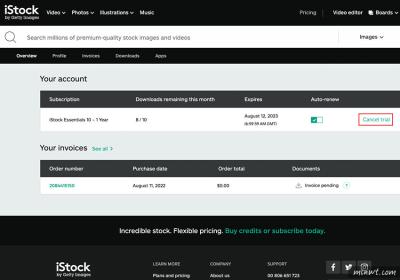Looking to turn your photography hobby into a source of extra income? Selling images on Shutterstock could be just the opportunity you need. Whether you’re a professional photographer or an enthusiastic hobbyist, Shutterstock offers a platform where your photos can reach a global audience and earn you money. It’s a win-win: you get to showcase your talent and make some income in the process. But before diving in, it’s helpful to understand how the platform works and what you need to succeed. Let’s explore the essentials of selling images on
Understanding Shutterstock and Its Market

Shutterstock is one of the biggest and most popular stock photography platforms out there. It’s a marketplace where photographers and designers upload their images, and buyers—from big corporations to small bloggers—purchase licenses to use them. The platform has millions of images, videos, and music tracks, making it a bustling hub for digital content. But what sets Shutterstock apart is its wide reach and user-friendly system, which makes it easier for contributors to get their work seen and sold.
Let’s break down some key aspects of Shutterstock and its market:
- Global Audience: Shutterstock attracts millions of users worldwide, offering your images exposure to diverse markets and industries.
- Revenue Model: Contributors earn money each time someone licenses one of their images. The payout depends on your contributor level and the type of license purchased.
- Content Types: Besides photos, Shutterstock also accepts videos, illustrations, vectors, and music tracks, giving you multiple ways to monetize your creativity.
- Quality and Trends: Shutterstock emphasizes high-quality images that meet industry standards. Staying updated with current trends—like popular themes or styles—can help your work stand out.
Understanding the market dynamics on Shutterstock means recognizing what buyers are looking for. Typically, this includes:
- High-Resolution, Clear Images: Sharp, well-composed photos are more likely to be purchased.
- Popular Themes: Business, technology, health, lifestyle, and nature are perennial favorites.
- Authenticity and Diversity: Genuine, diverse images resonate more with buyers seeking relatable content.
- Unique Perspectives: Offering fresh angles or niche subjects can give you an edge over the competition.
By understanding the platform’s mechanics and what it takes to succeed, you can craft a strategic approach to selling your images on Shutterstock. Remember, consistency and quality are key, and staying on top of market trends can help maximize your earnings. Ready to get started? Let’s dive into how you can prepare your portfolio and start uploading with confidence!
Preparing Your Photos for Submission
When it comes to selling your images on Shutterstock, the quality and presentation of your photos are crucial. Think of it like showcasing your artwork in a gallery — you want everything to look polished and professional. So, before hitting that upload button, here are some essential tips to prepare your photos for submission:
- Choose High-Resolution Images: Shutterstock prefers images that are at least 4 megapixels, but higher resolutions are always better. Aim for sharp, detailed photos that look great on any device or print size.
- Ensure Proper Focus and Composition: Blurry or poorly composed images don’t make the cut. Take time to focus correctly, frame your shot well, and follow basic photography principles like the rule of thirds.
- Adjust Brightness and Contrast: Use editing tools to enhance your photos. Brighten up underexposed images, adjust contrast to make elements pop, and ensure colors look natural.
- Remove Noise and Artifacts: Use noise reduction tools for low-light shots and clean up any distracting spots or blemishes. A clean, clear image is more appealing to buyers.
- Mind the Technical Specs: Save your images in JPEG format with a maximum of 15MB file size. Keep the color profile in sRGB for consistency across devices.
- Check for Copyright and Model Releases: Make sure you have the rights to all elements in your photo. If your shot features recognizable people or private property, secure the necessary releases beforehand.
Remember, quality beats quantity. Uploading multiple mediocre images won’t help your earnings. Instead, focus on creating a small portfolio of high-quality, versatile images that can be used in various contexts—think landscapes, business scenes, lifestyle shots, and abstract backgrounds. Take your time with editing, and don’t rush the submission process. The better your images look, the more likely they are to be accepted and purchased!
Creating a Shutterstock Contributor Account
Getting started as a Shutterstock contributor is straightforward, but there are a few steps to ensure your account is set up correctly. Think of it as opening a storefront—your account is your shop window to the world of buyers. Here’s a simple guide to creating your contributor account:
- Visit the Shutterstock Contributor Portal: Head over to submit.shutterstock.com. Click on the “Become a Contributor” button to start the registration process.
- Sign Up with Your Details: Fill out the registration form with your name, email, and create a secure password. Using a professional email address is recommended for better credibility.
- Read and Agree to the Contributor Terms: Make sure to review Shutterstock’s terms and conditions. They cover important points about licensing, royalties, and content guidelines.
- Verify Your Email: Check your inbox for a verification email. Click the link to activate your account.
- Complete Your Profile: Once logged in, fill out your profile details, including your payment information. You’ll need to provide tax details depending on your country, so have those ready.
- Upload Your First Images: After your account is set up, you can start uploading images. Follow the submission guidelines closely to increase your approval chances.
Pro tip: Take some time to explore the contributor dashboard. Familiarize yourself with the keywording tool, upload statuses, and sales reports. The more you understand how the platform works, the better you’ll be at optimizing your submissions for visibility and earnings.
Creating a strong, complete profile not only helps you get approved faster but also builds trust with buyers. Be professional, honest, and consistent in your submissions. As you grow your portfolio, you’ll find that earning extra income from Shutterstock becomes a rewarding and enjoyable side gig!
Uploading and Tagging Your Images Effectively
Alright, so you’ve taken some stunning photos and are ready to share them on Shutterstock. But here’s the thing—simply uploading your images isn’t enough. To maximize your chances of making sales, you need to upload thoughtfully and tag your images correctly. Think of it like setting up a shop: you want your products to be easy to find and appealing to the right audience.
Step 1: Prepare Your Images
- Make sure your images are high quality—sharpen, adjust colors, and crop if needed.
- Remove any watermarks or branding from your images.
- Save your files in the accepted formats (JPEG for photos, TIFF sometimes for vector images).
Step 2: Upload Your Images
When you’re ready, go to your Shutterstock Contributor account and hit the upload button. You can upload multiple images at once, which is a huge time-saver. As you upload, the platform will prompt you to fill in details for each image.
Step 3: Tagging Your Images
This is a crucial step. Proper tags help your images show up in relevant searches. Think about what potential buyers might search for. Use descriptive keywords that cover:
- Subjects (e.g., “mountain,” “business meeting”)
- Locations (e.g., “New York City,” “Golden Gate Bridge”)
- Colors (e.g., “blue,” “sunset orange”)
- Concepts or themes (e.g., “teamwork,” “relaxation”)
Shutterstock recommends adding at least 5-10 relevant keywords per image, but more is often better—up to 50 if possible. Avoid generic tags like “photo” or “image.” Instead, be specific and accurate. This improves your image’s visibility and attracts the right buyers.
Tip: Use tools like Google Keyword Planner or Shutterstock’s own search bar to see what related keywords are popular. Also, look at similar images and see which tags they use. This can give you ideas for effective keywords.
Tips for Increasing Your Image Sales
Once your images are uploaded and properly tagged, your next goal is to get them seen and purchased. Here are some tried-and-true tips to boost your sales and turn your photography hobby into a steady side income.
1. Consistency is Key
Upload regularly to keep your portfolio fresh. The more high-quality images you have, the higher your chances of being discovered. Set a schedule—whether it’s weekly or biweekly—and stick to it.
2. Focus on Trends and Demand
Stay updated on popular topics—think current events, seasonal themes, or emerging trends. Shutterstock’s trending keywords section can give you ideas. Creating images that match what buyers are searching for increases your chances of sales.
3. Use High-Quality, Unique Content
Stock buyers look for images that stand out. Invest time in capturing original, high-resolution photos. Avoid overused clichés unless you add a unique twist. Remember, originality can make your images more appealing.
4. Promote Your Portfolio
Share your Shutterstock portfolio on social media, your own website, or photography forums. Building an audience can lead to more views and sales. Engaging with communities also gives you feedback and new ideas.
5. Analyze Your Performance
Use Shutterstock’s analytics tools to see which images sell best. Pay attention to which keywords bring in traffic and adjust your tagging accordingly. Learning from your data helps you create more targeted content.
6. Offer Versatile Images
- Create images that work across multiple uses—business, lifestyle, nature, etc.
- Include various angles, compositions, and styles.
In the end, patience and persistence pay off. The more effort you put into uploading, tagging, and promoting your images, the more likely you are to see a steady stream of income from Shutterstock. Keep experimenting, stay current with trends, and enjoy the creative process!
Common Mistakes to Avoid When Selling on Shutterstock
Getting started with selling your images on Shutterstock can be exciting, but it’s easy to stumble into some common pitfalls that might hinder your success or even cause your content to be rejected. Let’s talk about a few mistakes to watch out for so you can set yourself up for a smooth and profitable experience.
Not Reading the Contributor Guidelines Carefully
Shutterstock has specific rules and standards for images, including technical requirements, content restrictions, and submission procedures. Many new contributors overlook these guidelines, leading to rejections or delays. Before uploading, take the time to thoroughly read the contributor resources so you’re clear on what’s acceptable.
Uploading Low-Quality or Poorly Edited Images
Remember, quality is king. Blurry, poorly lit, or heavily compressed images won’t make the cut. Use good equipment, pay attention to lighting, and always edit your photos for sharpness and color balance. High-quality images not only get accepted faster but also sell better.
Ignoring Keyword Optimization
Keywords are how buyers find your images. Don’t just add random tags or leave the description blank. Use relevant, specific keywords that accurately describe your image. Think about what someone searching for that scene or subject would type into the search bar.
Overlooking Model and Property Releases
If your images feature recognizable people, private property, or branded products, you need the appropriate releases. Uploading images without the necessary legal documents can lead to rejection or legal trouble down the line. Always obtain and properly file releases when required.
Uploading Too Many Similar Images at Once
While it’s tempting to upload a large batch of similar photos, quality beats quantity. Focus on submitting your best work and avoid flooding the platform with duplicates. This helps your portfolio look professional and increases your chances of sales.
Neglecting to Update Your Portfolio Regularly
Keep your portfolio fresh by regularly adding new images. A stagnant collection can give the impression that you’re not active or dedicated. Plus, new content can attract repeat visitors and boost your chances of making sales.
Misunderstanding the Licensing and Usage Rights
Be clear on the licensing options Shutterstock offers and what they entail. Understand the difference between royalty-free and rights-managed images, and choose the right license for your images. Misunderstanding this can lead to confusion or issues with buyers.
Legal Considerations and Copyright Guidelines
One of the most important aspects of selling images online is understanding the legal landscape. If you’re not careful, you could find yourself in hot water, facing copyright infringement claims or legal disputes. Let’s go over some key legal considerations and copyright guidelines to keep you compliant and protected.
Understanding Copyright and Your Rights
When you create original images, you automatically hold the copyright, giving you exclusive rights over how your work is used. Selling your images on Shutterstock involves licensing others to use your work, but your copyright remains with you unless you explicitly transfer it.
Model and Property Releases Are Essential
- Model Releases: Needed when your photos include recognizable people. This release grants permission for commercial use.
- Property Releases: Required if your images feature private property, trademarks, or branded products.
Without these releases, your images may be rejected, or you could face legal issues if used without consent.
Respect Trademarked and Copyrighted Content
Avoid including logos, trademarks, or copyrighted works in your images unless you have explicit permission. Shutterstock is strict about this, and including such content without clearance can lead to takedown notices or legal action.
Fair Use Does Not Apply
Remember, just because your image includes a copyrighted work doesn’t mean you’re protected under fair use. Commercial licensing means you need proper permissions, especially for protected logos, artwork, or branded items.
Understand the Licensing Options
| License Type | Description | Implications for Buyers |
|---|---|---|
| Royalty-Free | Buyers can use the image multiple times for various projects after a one-time fee. | More flexible, higher sales volume potential. |
| Rights-Managed | Uses are limited to specific purposes, durations, or geographic regions. | Often higher payout per license but more restrictions. |
Knowing which license to assign is crucial for legal clarity and ensuring you get paid appropriately.
Stay Informed and Consult Legal Advice if Needed
Legal rules can be complex, especially when dealing with international markets. If you’re unsure about certain images, releases, or licensing, consider consulting a legal professional specializing in intellectual property. Better safe than sorry!
In summary, understanding and adhering to legal and copyright guidelines is essential to building a reputable and sustainable income stream from your images on Shutterstock. Keep learning, stay compliant, and your creative work can be a reliable source of extra income for years to come.
Maximizing Your Earnings from Shutterstock Contributions
So, you’ve started uploading your images to Shutterstock—great! But how do you actually boost your earnings and make the most out of your contributions? Let’s dive into some practical tips that can help you maximize your income and stand out in the marketplace.
Understand the Marketplace
First things first, get to know what buyers are looking for. Browse Shutterstock regularly to see trending themes, popular styles, and the types of images that get lots of downloads. This insight can guide you in creating content that’s more likely to sell.
Focus on Quality and Relevance
High-quality images are your ticket to better earnings. Make sure your photos are sharp, well-lit, and composed thoughtfully. Avoid clutter and distractions. Additionally, include relevant keywords and descriptions—this is crucial for discoverability. Use specific tags that match what people might search for, like “modern workspace” or “summer vacation.”
Diversify Your Portfolio
Don’t put all your eggs in one basket. Upload a variety of images covering different themes, styles, and subjects. This not only broadens your appeal but also increases your chances of making sales across different categories.
Leverage Trends and Seasons
Stay current by creating images that align with ongoing trends or upcoming seasons and holidays. For example, stock images related to back-to-school, summer vacations, or festive seasons tend to see spikes in demand. Planning ahead can give you a competitive edge.
Optimize Your Upload Schedule
Consistency is key. Regular uploads keep your portfolio active and visible on the platform. Some contributors find success by uploading new images weekly or bi-weekly, ensuring their work stays fresh and relevant in Shutterstock’s search results.
Engage with the Community
Participate in forums or groups dedicated to stock photography. Sharing tips, receiving feedback, and learning from others can help you refine your craft and discover new opportunities for growth.
Monitor Your Performance
Use Shutterstock’s analytics tools to see which images perform best. Pay attention to downloads, earnings, and viewer engagement. This data can inform your future content strategy—focusing on what sells and refining what doesn’t.
Consider Exclusive vs. Non-Exclusive
Exclusive contributors often earn higher royalties, but they can’t sell the same images elsewhere. Weigh the pros and cons based on your goals. If you want maximum exposure and higher earnings per download, exclusivity might be worth considering.
Conclusion and Final Tips for Success
Embarking on your journey to sell images on Shutterstock can be both exciting and rewarding. Remember, success doesn’t happen overnight, but with dedication and strategic effort, you can turn your photography passion into a reliable income stream.
Here are some final tips to keep in mind:
- Quality over quantity: Upload only your best work.
- Stay consistent: Regular uploads keep your portfolio active.
- Keyword wisely: Use relevant, specific tags to improve discoverability.
- Research trends: Keep an eye on what’s popular and seasonal.
- Engage and learn: Join communities and utilize analytics to refine your approach.
Remember, persistence is key. Celebrate your small wins along the way and keep honing your craft. With patience and a strategic mindset, you’ll find your niche in the vast world of stock photography and enjoy the extra income it can bring. Happy shooting!


